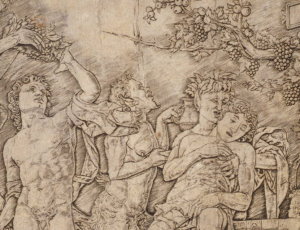
'Exhibit of the Month' is a series initiated by the Jagiellonian University Museum with the beginning of the new academic year. Each month we will explain the Museum collection to you, choosing a single exhibit or a group of exhibits which usually are not shown to the open public. This month's feature is a 15th-century copper engraving by Andrea Mategna.
Andrea Mantegna (1431-1506)
Bacchanalia with a cauldron
Copper engraving, drypoint
Size: 27,7 x 42,5 cm
Inventory no. MUJ 6201
Donated in 1928 by Prof. Józef Mycielski for the JU Cabinet of Archaeology and Arts
Andrea Mantegna was a painter and engraver, one of the leading Renaissance artists active in northern Italy. His legacy includes paintings, frescoes and engravings of considerable value, strongly influenced by ancient Greek and Roman sculpture. He was born the son of a humble carpenter in Isola di Carturo, a village near Padua, which was renamed Isola Mantegna in the 1960s to honour the artist's memory. While still a child, he began his training with Francesco Squarcione in Padua, in whose workshop, copying Greek and Roman artefacts, he acquired a thorough knowledge of ancient art. He married Nicolosia, daughter of the Venetian artist Jacopo Bellini — father of the famous painters Giovanni and Gentile Bellini.
Mantegna lived in Rome between 1488 and 1490 where he learned about ancient buildings, as well as statues that were collected by antiquarians and art collectors. In Renaissance Italy, the desire to gain knowledge about the ancients and eventually match gave birth to passion. Italian Renaissance artists necessarily became anatomists in an attempt to perfect the representation of the human figure, making their own research surpass even the knowledge of anatomy taught at universities.
In 1460, Andrea Mantegna and his family moved to Mantua after being invited by Ludovico Gonzaga. The artist became the court painter, but also the artistic advisor of the ruler and took custody over his art collection.
Mantegna was an early pioneer of copperplate art and his works were an inspiration for Albrecht Dürer. The artist's paintings are distinguished by his dramatic drawing, his mastery of perspective and his eminently classical treatment of the human figure. Mantegni's main achievement is considered to be the introduction of spatial illusionism in both frescoes and panel and canvas paintings, his virtuosity in the exercise of perspective, and his overflowing attention to detail.
The subject of the engraving Bacchanalia with a Cauldron is the rites in honour of Bacchus, which have been a frequent subject of artistic representation since antiquity. Andrea Mantegni's work departs from the popular iconography of Renaissance Bacchanalia which usually showed a Bacchic procession with a triumphal carriage and symbolised the ideal of youth, joy of life and freedom from sorrow.
The presented engraving is a representation with a rather moralistic and bitter tone, bereft of any signs of joy. The composition can be considered as complementary (pendant) with the Bacchanalia with Silene, which are engraved on the reverse of the same panel and are related in style, technique, subject and dimension. This is one of the few surviving prints of the Bachanalia with a Cauldron by the same artist (a print of this engraving is also held by the Metropolitan Museum of Art in New York). This composition and the accompanying Bacchanalia with Sylene were inspired by the ancient Bacchic sarcophagi that Mantegna viewed in Rome. Drunken figures gather around a cauldron of wine, filling the space with mournful majesty. The unconscious young man in the centre of the engraving is supported by a mourning figure, much like Christ in the Pietà. Dionysus may be the standing youth on the left, crowned with a wreath of grape leaves. His noble proportions and the contraposto of the figure, link him to ancient sculptures.
In his Lives of the Most Excellent Painters, Sculptors, and Architects, Georgio Vasari (1511-1574) praises Mantegna as a great painter, writing that his works have a three-dimensional, sculptural plasticity. Unfortunately, Vasari also emphasises the artist's quarrelsomeness.
Andrea Mantegna died in Mantua in 1506 after almost 50 years of work at the Gonzagas' court.

